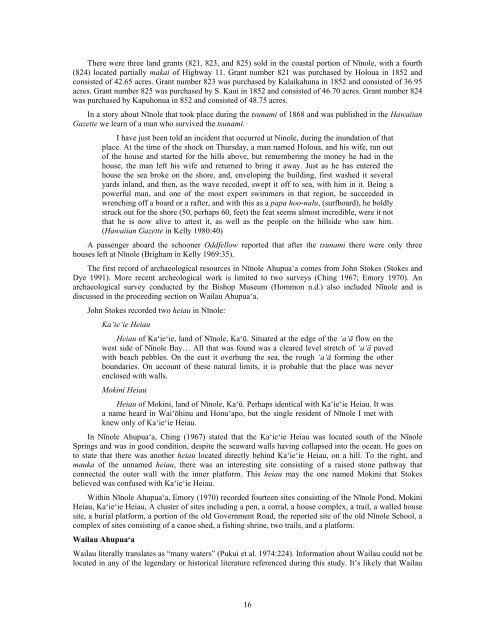Honu'apo Park Resource Management Plan
Honu'apo Park Resource Management Plan
Honu'apo Park Resource Management Plan
You also want an ePaper? Increase the reach of your titles
YUMPU automatically turns print PDFs into web optimized ePapers that Google loves.
There were three land grants (821, 823, and 825) sold in the coastal portion of Nīnole, with a fourth<br />
(824) located partially makai of Highway 11. Grant number 821 was purchased by Holoua in 1852 and<br />
consisted of 42.65 acres. Grant number 823 was purchased by Kalaikahuna in 1852 and consisted of 36.95<br />
acres. Grant number 825 was purchased by S. Kaui in 1852 and consisted of 46.70 acres. Grant number 824<br />
was purchased by Kapuhonua in 852 and consisted of 48.75 acres.<br />
In a story about Nīnole that took place during the tsunami of 1868 and was published in the Hawaiian<br />
Gazette we learn of a man who survived the tsunami.<br />
I have just been told an incident that occurred at Ninole, during the inundation of that<br />
place. At the time of the shock on Thursday, a man named Holoua, and his wife, ran out<br />
of the house and started for the hills above, but remembering the money he had in the<br />
house, the man left his wife and returned to bring it away. Just as he has entered the<br />
house the sea broke on the shore, and, enveloping the building, first washed it several<br />
yards inland, and then, as the wave receded, swept it off to sea, with him in it. Being a<br />
powerful man, and one of the most expert swimmers in that region, he succeeded in<br />
wrenching off a board or a rafter, and with this as a papa hoo-nalu, (surfboard), he boldly<br />
struck out for the shore (50, perhaps 60, feet) the feat seems almost incredible, were it not<br />
that he is now alive to attest it, as well as the people on the hillside who saw him.<br />
(Hawaiian Gazette in Kelly 1980:40)<br />
A passenger aboard the schooner Oddfellow reported that after the tsunami there were only three<br />
houses left at Nīnole (Brigham in Kelly 1969:35).<br />
The first record of archaeological resources in Nīnole Ahupua‘a comes from John Stokes (Stokes and<br />
Dye 1991). More recent archeological work is limited to two surveys (Ching 1967; Emory 1970). An<br />
archaeological survey conducted by the Bishop Museum (Hommon n.d.) also included Nīnole and is<br />
discussed in the proceeding section on Wailau Ahupua‘a.<br />
John Stokes recorded two heiau in Nīnole:<br />
Ka‘ie‘ie Heiau<br />
Heiau of Ka‘ie‘ie, land of Nīnole, Ka‘ū. Situated at the edge of the ‘a‘ā flow on the<br />
west side of Nīnole Bay… All that was found was a cleared level stretch of ‘a‘ā paved<br />
with beach pebbles. On the east it overhung the sea, the rough ‘a‘ā forming the other<br />
boundaries. On account of these natural limits, it is probable that the place was never<br />
enclosed with walls.<br />
Mokini Heiau<br />
Heiau of Mokini, land of Nīnole, Ka‘ū. Perhaps identical with Ka‘ie‘ie Heiau. It was<br />
a name heard in Wai‘ōhinu and Honu‘apo, but the single resident of Nīnole I met with<br />
knew only of Ka‘ie‘ie Heiau.<br />
In Nīnole Ahupua‘a, Ching (1967) stated that the Ka‘ie‘ie Heiau was located south of the Nīnole<br />
Springs and was in good condition, despite the seaward walls having collapsed into the ocean. He goes on<br />
to state that there was another heiau located directly behind Ka‘ie‘ie Heiau, on a hill. To the right, and<br />
mauka of the unnamed heiau, there was an interesting site consisting of a raised stone pathway that<br />
connected the outer wall with the inner platform. This heiau may the one named Mokini that Stokes<br />
believed was confused with Ka‘ie‘ie Heiau.<br />
Within Nīnole Ahupua‘a, Emory (1970) recorded fourteen sites consisting of the Nīnole Pond, Mokini<br />
Heiau, Ka‘ie‘ie Heiau, A cluster of sites including a pen, a corral, a house complex, a trail, a walled house<br />
site, a burial platform, a portion of the old Government Road, the reported site of the old Nīnole School, a<br />
complex of sites consisting of a canoe shed, a fishing shrine, two trails, and a platform.<br />
Wailau Ahupua‘a<br />
Wailau literally translates as “many waters” (Pukui et al. 1974:224). Information about Wailau could not be<br />
located in any of the legendary or historical literature referenced during this study. It’s likely that Wailau<br />
16


